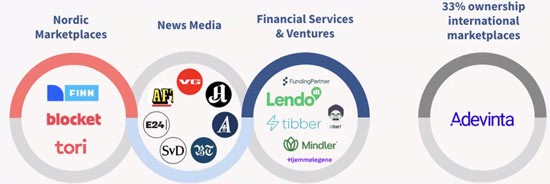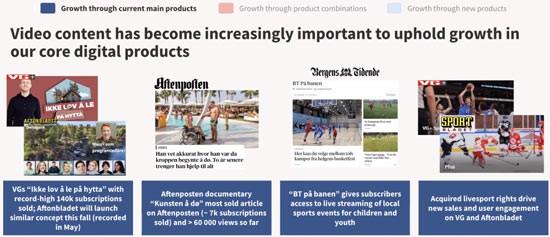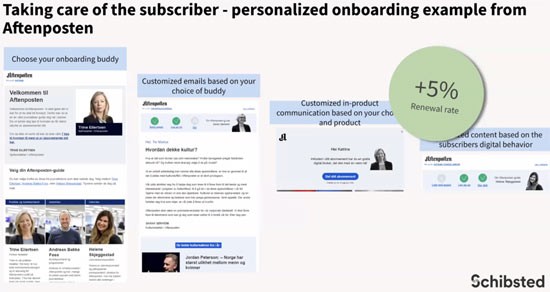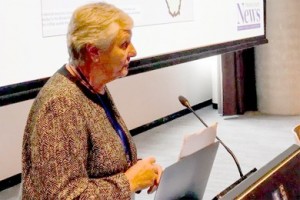A high-profile podcast channel in which Schibsted was a start-up investor has turned out to be the Nordic media giant’s biggest growth brand.
Presenting the closing keynote in WAN-Ifra’s virtual Indian Media Leaders e-summit today, Tor Jacobsen (pictured) told how the PodMe platform – which features famous presenters on long contracts – has seen tremendous growth.
Initially a venture, it is now 90 per cent Schibsted owned, and with 185,000 subscribers has become the group’s fastest-growing product and a leader in Sweden.
Jacobsen told of the realisation Schibsted could compete in the market, given that people like to listen in their own language. “It’s now our third-largest subscription product and a very important driver for us in terms of revenue,” he said.

The Oslo-based senior vice president for consumer revenue and subscription said newsmedia was still the group’s biggest earner, even following a merger with Ebay over Adevinta, of which it owns a third.
Having passed a million digital subscribers only last year, Schibsted now has more than 1.5 million in a digital business worth US$130 million and set to overtake print revenue this year. “It’s gone very fast, and to have a big subscription base will be very important strategically,” Jacobsen says.
And with analysts told the group will double that by 2025, a number of new initiatives have been launched to drive growth, based on the “megatrend” of subscription growth which supports companies such as Tesla, Apple and Amazon.

Revenue targets will be achieved by improving existing products, adding layers and new products, and earning more from product combinations. Video content has been “increasingly important” to upholding growth in core digital products, with 35 per cent of sales last year coming from it. This included “very expensive” sports rights, more and more local content, documentaries and pure entertainment.
“We plan to make people stay longer, and bundle content with relevant products,” Jacobsen said, adding that Schibsted had previously been “a little conservative” on pricing.
“People have a high willingness to pay, and sometimes higher than we think.”

With personalisation, a recent success had been “personal onboarding” and taking care of a subscriber, leading to higher renewal rates and engagement.
It’s also been “super important” to get people to share their subscription, resulting in much lower churn.
Product combinations are being tested in both Norway and Sweden with good results, and later this year Schibsted will launch an “all brands” bundle for which tests also indicate lower churn and higher engagement. “One package with all the media brands, everything open, will be super exciting for us.

“There are still some things to sort out, such as sharing revenue, and sales strategy, but we’re hoping for at least 10,000 subscribers, and are also looking at reward programmes for loyal customers.
“We’ll have two million subscribers by then, and a platform on which we can sell things,” he said.
Indian delegates wanted to know about short format video – finding a good business model on TicToc was “harder” – whether to break exclusives in print or digital, and the use of integrated technologies such as AI. A surprise was that PDF versions of the upcoming day’s print edition were made available to print subscribers at 10pm the previous day.
Jacobsen’s presentation closed three days of afternoon sessions which had attracted more than 250 delegates from 40 organisations.
Themed ‘Ideas for news realities’, the conference covered a range of news publishing topics, such as digital transformation, changing audience engagement trends, business innovation, newsroom leadership, and diversity and inclusion.
Opening keynoter was JP/Politikens Hus chief executive Stig Ørskov – who is vice president of WAN-Ifra – with a recipe for growth based on “the true value of content and how we monetise it”.
Raju Narisetti – now a publishing leaders with McKinsey & Co – quizzed Quint co-founder Ritu Kapur on emerging opportunities in newsmedia. Publishers had to create “a layer of experience that is unique to their brand” to create value and bring people back.
A panel discussion brought together ABP chief executive Dhruba Mukherjee, Unica Token director Bhaskar Das, Jang Media managing director Sarmad Ali and HT Media executive director Rajeev Beotra. To be successful in the future, media companies had to pivot to the business of content – not restricted to format – and change their business model, members agreed.
Earlier, Bennett Coleman & Co executive president Mohit Jain, who is a WAN-Ifra board member and president of Indian Newspaper Society, opened the eSummit, sharing his optimism for newsmedia. “’Til the time the curiosity in human nature will survive or remain, content will never get out of fashion,” he said.
The second day addressed challenges within the newsroom: Singapore Press Holdings’ Gaurav Sachdeva told how the brand’s audience helped it create products “to meet real needs and expectations” using a combination of technology, viability of business and empathy for people.
A panel including Kunal Pradhan (Hindustan Times), Harsha Mathew (Malayala Manorama), Debarati Guha (Deutsche Welle) and Parikshit Bhardwaj (Jagran New Media) discussed the challenges of a post-pandemic newsroom. News content and format had changed because of the pandemic, making way for data-researched and video stories, strengthening the belief in the choice of stories, and making newsrooms more efficient.
Later, a session on the business case to build a diverse and inclusive newsroom and diversity practices at German broadcaster Deutsche Welle, came from editor Akansha Saxena.
Peter Coleman with WAN-Ifra/Neha Gupta
















Comments